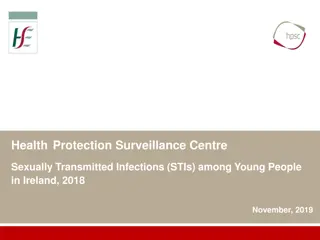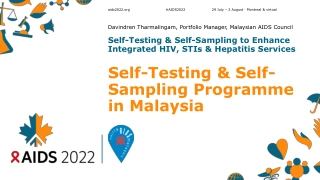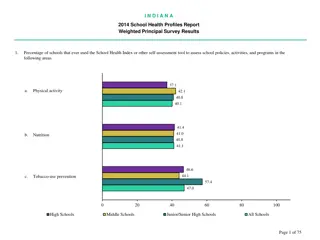Understanding Common Women's Health Issues Related to STIs
Women's presentations at STI clinics can be either physiological or pathological, often associated with common STIs. The physiology of the vulvovaginal area serves as the first line of defense against infections, and the maintenance of a healthy microbiota plays a crucial role in vulvovaginal health. Factors such as hormonal shifts, hygiene practices, and sexual intercourse can impact the composition of vaginal microflora. A healthy vagina is typically dominated by Lactobacillus, promoting an acidic environment to prevent colonization by harmful bacteria.
Uploaded on Sep 23, 2024 | 0 Views
Download Presentation

Please find below an Image/Link to download the presentation.
The content on the website is provided AS IS for your information and personal use only. It may not be sold, licensed, or shared on other websites without obtaining consent from the author. Download presentation by click this link. If you encounter any issues during the download, it is possible that the publisher has removed the file from their server.
E N D
Presentation Transcript
Common presentation of women to the STI clinic Can be physiological or pathological Related with some common STIs
Physiology/ vulvovaginal area The vulva is the first line of defense to protect the genital tract from infection. Contaminants often collect in the vulvar folds Increased moisture, sweating, menses, and hormonal fluctuations influence vulvar microbial growth. Vulvar skin differs in hydration, friction, permeability, and visually discernible irritation and is more susceptible to topical agents The non-keratinized vulvar vestibule is likely to be more permeable than keratinized skin.
Genital skin is unique in that it is covered by a thin stratum corneum containing large hair follicles, making it easier for microbial and other substances to permeate the skin. The vagina is the fibromuscular canal extending from its external opening in the vulva to the cervix Composed mainly of smooth muscle covered with a non-keratinized epithelial lining, which, until the menopause, is thick, with folds kept moist by fluid secreted through the vaginal wall and mucus from cervical and vestibular glands
Microflora Maintenance of the microbiota ratio is anticipated to play a key role in overall vulvovaginal health. The normal vulvar flora includes vaginal, urethral, and colonic microbes as well as microbes characteristic of intertriginous skin. Microbiota of the vulva is diverse, with no single species common to all women and these may include staphylococci, micrococci, diphtheroids, lactobacilli, streptococci, Gram-negative rods, yeasts, and species of fecal origin.
A healthy vagina is dominated by Lactobacillus A non-sporing, Gram-positive bacilli that produce lactic acid, resulting in an acidic environment (pH 3 4). Prevent colonization by other bacteria in the vagina via competition for epithelial cell receptors and through inhibition of growth by generation of antimicrobial compounds in collaboration with innate host defenses (e.g. periodic hormonal cycling promoting glycogen release and constant sloughing of bacteria-containing epithelial cells).
The composition of the vaginal microflora fluctuates as a function of: 1. Internal factors (age, hormonal shifts (e.g. during menarche, menses, and pregnancy), and infections) 2. External factors (e.g. hygiene practices, sexual intercourse, the use of antibiotics, and hormone replacement therapy).
PH Vulvar pH could be expected to be around 4.7 Vaginal PH (average pH 3.5) 3.8 to 4.2 during the menstrual cycle. Various factors may affect vulvar pH, including endogenous factors (e.g. humidity, sweat, vaginal discharge, menstruation, urine and fecal contamination, anatomical folding, genetics, and age) and exogenous factors (e.g. soap, detergents, cosmetic products, lubricants and spermicides, occlusion with tight clothing or sanitary pads, shaving, and depilation products). Prolonged drying of the vulvar skin has been shown to significantly reduce its PH.
Vulvovaginitis Vaginitis is the general term for disorders of the vagina caused by infection, inflammation, or changes in the normal vaginal flora. Around 90% of vaginitis is caused by infection, mainly bacterial vaginosis Less common causes include: vaginal atrophy/atrophic vaginitis, cervicitis, foreign body, irritants and allergens, and several rarer entities, including some systemic medical disorders, vulvovaginal candidiasis, and trichomoniasis
Prepubertal Vaginal discharge is the most common reason for referral of a prepubertal girl to a gynaecologist. Non-specific bacterial vulvovaginitis is the most frequent cause. Associated symptoms include soreness and itching, which can be chronic and distressing. Vulval hygiene and the use of appropriate emollients form the successful management. The most frequent age of referral is between 3 10 years. ?Sexual abuse
Why? The labia are small, undeveloped and there are no labial fat pads or pubic hair. The anus is anatomically very close to the vagina. Thus, there is the risk of faecal contamination, which can lead to infection. The vulval and vaginal skin are hypoestrogenic and, therefore, thin and delicate. The squamous epithelium is undifferentiated and unestrogenised and the pH is neutral.
Vulvovaginitis is the most common cause of prepubertal vaginal discharge and can be infective or chemical. Other rare causes include insertion of a foreign body and vaginal/vulval tumours. Non-gynaecological causes, such as threadworm infection, must be considered, as well as unusual congenital anomalies such as ectopic ureters
Vulvovaginitis The most common symptom is vaginal discharge (62 92%) The discharge can be clear, yellow or green and may be offensive smelling. Other symptoms of vulvovaginitis include redness and soreness,pruritus and dysuria. Vaginal bleeding is an unusual symptom of vulvovaginitis More serious causes, such as tumours, precocious puberty and sexual abuse, must be excluded before attributing bleeding to vulvovaginitis.
P/E On inspection of the genital area: 1. The skin around the vagina will look reddened and inflamed and this may extend around the anus. 2. There may be a pool of discharge at the posterior fourchette. 3. There may be excoriation of the genital area if it is itchy.
Non-specific bacterial vulvovaginitis Most commonly, the vulvovaginitis is non-specific, with mixed bacterial flora. Vaginal cultures will be reported as non-specific skin flora or will show mixed anaerobes or coliforms from the gut. Poor personal hygiene is a common trigger factor, as the onset of symptoms usually occurs when the child has responsibility for her own anal hygiene; for example, on first attending nursery or school.
Infective causes The most common infective agent to be found in prepubertal vaginal discharge is the group A betahaemolytic streptococcus. Acute, with a seropurulent vaginal discharge. May be associated with dysuria and an inflamed vulva. Group A streptococci are sensitive to penicillin. Topical antibiotics are of no use for treatment of vaginal infection.
Haemophilus influenzae is the second most common cause of vulvovaginitis. Girls are more likely to have recurrent symptoms with Haemophilus. Most strains are sensitive to penicillin.
Candida is a very uncommon cause of vulvovaginitis in the prepubertal girl Predisposing factors recent course of antibiotics, diabetes or the wearing of nappies. If present, the symptoms are similar to those of adult women: pruritus and a white, curd-like discharge. Inflammation of the vulva and perineal area and white plaques adherent to the vagina often occur. Treatment is usually with a topical antifungal agent.
Some systemic infections such as varicella, measles and rubella can cause an associated vulvovaginitis, which can be severe. Resolution is usually complete A secondary bacterial infection from vulval organisms can occur and prolong symptoms
Vulval dermatitis Most commonly causes vulval soreness but this can be associated with discharge. Irritant dermatitis has been reported as a result of using soap or bubble bath and playing in a sandpit, as well as prolonged contact of urine and faeces against the skin. Avoidance of the irritative agent should lead to resolution of symptoms. Allergic contact dermatitis may develop as a result of prolonged exposure to irritant substances, such as perfumes and clothing dyes. Accurate allergy patch testing may help to identify the culprit
Vulval skin disorders Present with vulval irritation and soreness. Vaginal discharge is usually a less prominent feature Atopic eczema can affect up to 15% of young
Emollients are the mainstay of treatment The use of mild or moderate strength steroid cream may be necessary for short periods. Lichen sclerosis usually presents with itching and soreness. Vaginal discharge is unusual unless there is a secondary infection but bleeding can occur from purpura and blister formation Symptoms can be persistent and may only resolve completely with the approach of puberty and increasing estrogenisation of the vulva and vagina.
Foreign bodies Unusual cause of vaginal discharge. They should be considered in a girl who keeps presenting with recurrent or chronic vaginal discharge and in the presence of bloodstained or very offensive discharge. A vaginal discharge with an irritant vulvitis is usually the first sign. The discharge may be purulent, foul smelling and occasionally bloodstained
Tumours Rare tumours such as embryonal rhabdomyosarcoma, mesonephric carcinoma and clear cell adenocarcinoma of the vagina or cervix all present with a bloodstained discharge. Sometimes a tumour is visible at the introitus. Vaginal bleeding or bloodstained vaginal discharge needs urgent referral to an appropriate specialist for evaluation.
Sexual abuse Must always be considered in girls with recurrent or persistent vaginal discharge or bleeding. If the child is old enough it is important to ask her about any inappropriate touching of the genital area. The majority of children who are abused do not have any physical complaints related to trauma or infection
Postmenopausal Following menopause, and as estrogen levels fall, vaginal pH increases. This alkaline pH is associated with increased colonization with pathogenic microbes. Vulvar skin disorders are also more prevalent after the menopause. Dermatoses must also be considered.
Vulvovaginal atrophy Present in 95% of women. No discharge. Dysparunia, dryness. Topical estrogen.
Vulval candidiasis Irritation and soreness. Contributing factors: Obesity, DM,antibiotic use. May become chronic. Satellite lesions, excoriations,inflammation and edema. Treatment: Prolonged topical antifungal therapy.
Lichen Sclerosus Chronic inflammation. ?Autoimmune Severe pruritis, worse at night. Figure of 8 distribution. Dysparunia pruritis and discomfort. Skin :erythema, atrophy, hyperketosis( extra white). Fusion of labia minora, clitoris , narrowing of introitus. 4% Squamous Cell Carcinoma Treatment:ultrapotent corticosteroids.
Lichen Planus Polygonal,Purple Plaques Wickham s striae Glazed appearance Usually erosive Dysparunia and pain ?Autoimmune Not linked to hormonal status Treatment: High potency corticosteroids
Lichen Simplex Chronic inflammation Severe pruritis, worse at night Linked to stress and low iron stores Exacerbated by chemical irritants, contact dermatitis. Treatment : Antihistamines, corticosteroids
Extramammary Pagets disease Rare Might be associated with adenocarcinoma Imaging must be done to breasts, GI and urinary tracts Treatment: Surgery
For a year or two before puberty, until after menopause, it is normal and healthy for a woman to produce a vaginal discharge. Consists of bacteria and desquamated epithelial cells that slough from the vaginal walls together with mucus and fluid (plasma) produced by the cervix and vagina. The quantity and texture of this change during the menstrual cycle: vaginal discharge is thick, sticky, and hostile to sperm at the beginning and end of the menstrual cycle when estrogen is low and gets progressively clearer, watery, and more stretchy as estrogen levels rise prior to ovulation.
The discharge may become more noticeable at times (physiological leukorrhea ), such as at midmenstrual cycle close to the time of ovulation or during pregnancy or use of estrogen-progestin contraceptives. Diet, sexual activity, medication, and stress can also affect the volume and character of normal vaginal discharge
Bacterial Vaginosis Most common cause of discharge in women of child-bearing age. Overgrowth of anaerobic organisms( Gardenella vaginalis) mainly. Decrease in Lactobacilli. PH 4.5 7 Sexually active and non-sexually active Black, Smoking, IUCD use 50% Asymptomatic Offensive,Fish-smelling vaginal discharge Thin white discharge on the wall of vagina an vestibule
Diagnosis Amsel s criteria 3 out of 4
Treatment 1. Advice against vaginal douching, antiseptics and vaginal shower gels. 2. Antibiotic treatment :1. Symptomatic women 2. Undergoing surgery 3. Pregnant women Metronidazole 500mg 1*2 for 5-7 days Metronidazole vaginal gel once daily for 5 days Clindamycin vaginal cream 2% once daily for 7 days ** Do not treat male partner
CLINICAL FEATURES 1. Thick white (curd like) 2. non offensive vaginal discharge 3. Vulval itching 4. Vulval soreness 5. Superficial Dyspareunia (due to the vulval irritation) Signs Erythema Fissuring Vulval oedema
Predisposing Factors Diabetes mellitus Long term steroids Pregnancy Prolonged antibiotic use Immune suppression
Samples Vaginal swabs from lateral fornix Investigations Microscopy of vaginal smear Gram stain Hyphae and spores Culture Sabouraud agar medium
Management Good hygiene Remove predisposing factors Oral Triazoles drugs- Fluconazole 150mg stat or Itraconazole 200mg bd Topical applications- Clotrimazole, Miconazole, Nystatin Pessaries and clotrimazole cream intravaginally daily for 7-14 days **No epidemiological treatment for partner
Trichomoniasis Organism Trichomonas Vaginalis Flagellated protozoan found in the vagina,urethra,paraurethral glands Almost exclusively sexual in adults 10-50% Asymptomatic Symptoms: 1. Very foul smelling discharge 70%( Variable!! thin and scanty yellow, profuse and thick) 2. Itching 3. Dysuria
Risk factors People with more sexual partners are more likely to become infected. Older women may be more likely than younger women to be infected. Black women may be more likely to be infected. Other risk factors for infection may include limited education and low socioeconomic status.
Vulvitis,vaginitis and cervicitis Classic Strawberry Cervix Diagnosis: A wet smear from the posterior fornix Culture Observed for motile Flagellated organism Giemsa Culture
Treatment Metronidazole/tinidazole 2g stat orally Metronidazole 4500mg 1*2 for 5-7days ** Treat partner ** Avoid sexual relationships until both partners complete treatments

















































